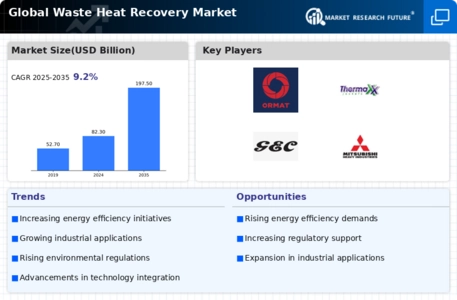Top Industry Leaders in the Waste Heat Recovery Market

The global market for waste heat recovery systems is experiencing robust growth, driven by a convergence of environmental concerns, escalating energy expenses, and technological advancements. In the coming years, this growth manifests as a highly competitive and innovative market. Let's explore the key players, their strategies, and the continually evolving landscape that shapes this dynamic industry.
Key Market Players and Their Approaches:
- Alstom SA (France)
- ABB Ltd. (Switzerland)
- Amec Foster Wheeler (U.K.)
- Ormat Technologies Inc. (U.S.)
- General Electric Co. (U.S.)
- Mitsubishi Heavy Industries Ltd. (Japan)
- Echogen Power Systems Inc. (U.S.)
- Econotherm Ltd. (U.K.)
- Thermax Limited (India)
- Siemens AG (Germany)
- China Energy Recovery Inc. (China)
- Cool Energy Inc. (U.S.), among others.
Established Industry Leaders: Companies like Siemens, ABB, and Mitsubishi Heavy Industries leverage their strong brand recognition, global reach, and expertise in large-scale projects to cater to heavy industries such as steel and cement. Their focus lies on delivering robust, customized solutions and providing comprehensive after-sales service.
Innovators in Technology: Emerging players like Exergy Energy Solutions and Echogen Power Systems are establishing a niche with their emphasis on developing cutting-edge technologies like Organic Rankine Cycle (ORC) systems and micro-CHP units. These solutions target smaller industries and distributed energy applications, offering greater flexibility and adaptability.
Regional Pioneers: Local players like Forbes Marshall in India and Alfa Laval in Sweden play a pivotal role in their respective regions, tailoring their offerings to suit specific industry needs and regulatory frameworks. Their agility and proximity to customers give them an edge in certain markets.
Factors Influencing Market Share:
-
Technology Leadership: Companies with advanced heat transfer technologies, energy conversion systems, and data analytics capabilities command a premium. The ability to seamlessly integrate with existing industrial processes and optimize energy use is paramount. -
Project Execution Expertise: Successfully delivering complex waste heat recovery projects on time and within budget demands strong project management skills, supply chain logistics, and engineering know-how. A proven track record in successful project execution builds trust and attracts repeat business. -
Financial Strength and Partnerships: The upfront capital cost of waste heat recovery systems can be a barrier for some clients. Offering financing options, partnering with financial institutions, and securing government grants can play a crucial role in securing market share. -
Sustainability Focus: Corporate social responsibility and environmental impact are increasingly crucial considerations for clients. Companies showcasing a strong commitment to sustainability through efficient systems and reduced carbon footprint gain a competitive edge.
Emerging Trends:
-
Digitalization and IoT: Integration of sensors, data analytics, and AI-powered controls is optimizing system performance, predictive maintenance, and remote monitoring, offering cost savings and improving overall efficiency. -
Modular and Scalable Solutions: Pre-packaged and standardized systems are gaining traction, catering to smaller industries and reducing customization costs, making waste heat recovery accessible to a wider range of clients. -
Distributed Energy and Microgrids: Integrating waste heat recovery with renewable energy sources like solar and wind is creating decentralized energy solutions for buildings and communities, promoting energy independence and sustainability. -
Hybrid Systems: Combining different waste heat recovery technologies, such as ORC with Organic Rankine Cycle Bottoming (ORCB) systems, is improving overall energy extraction and utilization, maximizing returns on investment for various heat sources.
Overall Competitive Scenario: The waste heat recovery system market is shifting from primarily focusing on heavy industries to embracing diversified applications and smaller-scale solutions. Innovation is driving technological advancements, with digitalization and hybrid systems leading to more efficient and flexible solutions. While established players continue to dominate, smaller companies with niche expertise and regional focus are carving their space. Collaboration and partnerships are becoming increasingly important as players co-develop technologies and address specific market needs. In conclusion, the competitive landscape of the waste heat recovery system market is dynamic and evolving. Adaptability, continuous innovation, and a focus on sustainability will be key for players to thrive in this promising and burgeoning industry.
Industry Developments and Updates: Alstom SA (France):
-
Date: November 15, 2023 -
Source: Alstom Press Release -
Development: Alstom and ENGIE partner to launch a waste heat recovery project at a French steel plant. The project is expected to generate 10 MW of renewable energy from waste heat, reducing CO2 emissions by 20,000 tons annually.
ABB Ltd. (Switzerland):
-
Date: December 5, 2023 -
Source: ABB website -
Development: ABB launches its latest Turbex® K series industrial turbochargers, specifically designed for waste heat recovery applications in cement and steel industries. The new series offers improved efficiency and reduced emissions.
Amec Foster Wheeler (U.K.):
-
Date: October 26, 2023 -
Source: Amec Foster Wheeler website -
Development: Amec Foster Wheeler awarded a contract to design and supply a waste heat recovery system for a petrochemical plant in the Middle East. The system is expected to generate 50 MW of electricity, reducing energy consumption by 15%.
Ormat Technologies Inc. (U.S.):
-
Date: December 12, 2023 -
Source: Ormat Investor Presentation -
Development: Ormat announces record quarterly revenue driven by strong demand for its waste heat recovery solutions, particularly in geothermal and industrial applications. The company expects continued growth in the waste heat recovery market.

